Coquettish Colette Darfeuil (1906-1998) was a French actress with beautiful green eyes who made 110 films between 1920 and 1953.
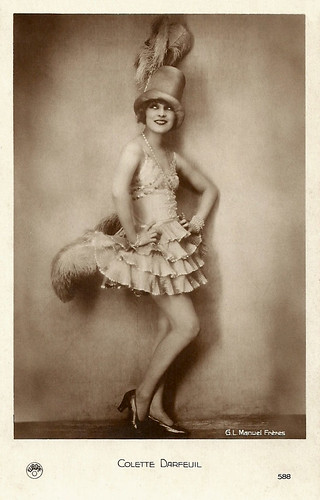
French postcard by Europe, no. 588. Photo: G.L. Manuel Frères.
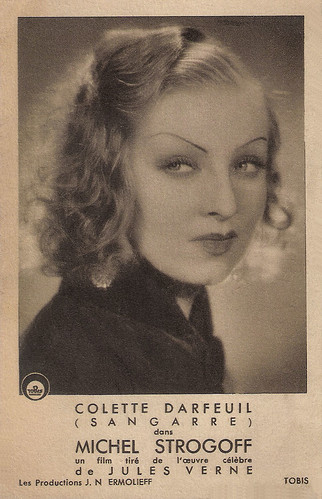
French postcard by Les productions J.N. Ermoliev / Tobis for the screening of the film at the Paris cinema Marivaux. Colette Darfeuil as the evil Sangarre, who plots together with Ivan Ogareff (Charles Vanel) in the French sound film Michel Strogoff (Jacques de Baroncelli, Richard Eichberg, 1936), based on the novel by Jules Verne.
Colette Darfeuil was born Emma Henriette Augustine Floquet in Paris in 1906. As a girl, she was discovered by young director Pierre Colombier in the Gaumont studios when she accompanied a friend who would play a part as an extra.
She made her film debut in Les étrennes à travers les ages/New Year Gifts through the Ages (Pierre Colombier, 1920) with Dolly Davis. This was a short, silent comedy with animated sequences of women down the ages all wanting something different from what they got as New Year presents.
Three years later, her film career really took off with leading roles in Le retour à la vie/Back to Life (Jacques Dorval, 1923) and Château historique/Historic Castle (Henri Desfontaines, 1923) with Thomy Bourdelle.
In Germany, she appeared in Der Mann im Sattel/The Man in the Saddle (Manfred Noa, 1925) with Ernö Verebes and Angelo Ferrari. There she later also appeared in the comedy Was eine Frau im Frühling träumt/What a Woman Dreams About in Spring (Curt Blachnitzky, 1929).
But she mostly appeared in French films, such as the dramas La flamme/The Flame (René Hervil, 1926) with Charles Vanel, and Sables/Sand (Dimitri Kirsanoff, 1929) with Gina Manès. She had started her career as a brown-haired ingénue but in time turned into a blonde sophisticated lady.
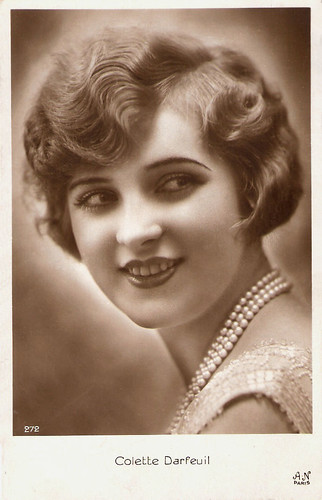
French postcard by A.N. Paris, no. 272.
Colette Darfeuil made an easy transition from silent to sound with Abel Gance’s Science-Fiction film La fin du monde/The End of the World (1931). Hal Erickson at AllMovie: “As a comet speeds along on a collision course with Planet Earth, the world prays for a miracle. Scientist Victor Francen races against time to avoid the cataclysm, while Francen's religious-fanatic brother (played by director Gance) puts his fate in the hands of God.
Meanwhile, the governments of the world adopt near-fascistic methods to keep their panicking minions under control. Once all hope is abandoned, virtually all of civilisation degenerates into a drunken orgy, replete with rape and bestiality. The worst is reserved for last, as the ever-approaching comet causes a plethora of natural disasters before the final ‘Big Bang.’“
The 1930s were a busy decade for Darfeuil. It started with films like Cendrillon de Paris/Cinderella of Paris (Jean Hémard, 1930) and the comedy Voici dimanche/Here is Sunday (Pierre Weill, 1930) with Tony D’Algy. She played leads in Pour un soir..!/For one night...! (Jean Godard, 1931) opposite the young Jean Gabin, and the Guy de Maupassant adaptation Le rosier de Madame Husson/Mrs. Husson's Virginity Prize (Dominique Bernard-Deschamps, 1932) featuring Françoise Rosay.
Rex Ingram and his wife Alice Terry directed her in a supporting part in the Arab adventure Baroud (1932) with Pierre Batcheff. The British director shot his only sound film in Morocco, during the heyday of the French colonial empire, and retired shortly afterwards from the film industry. Russian director Fyodor Otsep directed her in the drama Mirages de Paris/Paris Illusions (1933) with Jacqueline Francell. This was an alternate language version of Großstadtnacht/Big City Night (Fyodor Otsep, 1932) with Dolly Haas and Trude Berliner in Darfeuil’s role.
Other films include Pour être aimé/To be Loved (Jacques Tourneur, 1933) with Pierre Richard-Willm, the Fernandel comedy Les bleus de la marine/The New Recruits of the Navy (Maurice Cammage, 1934), and Le roi des Champs-Élysées/The King of the Champs Elysees (Max Nosseck, 1934) with Buster Keaton.
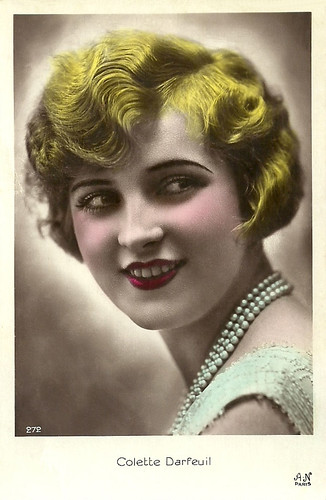
French postcard by A.N. Paris, no. 272.
Colette Darfeuil had a successful career but never managed to become a real star. She often played seductive femme fatales, sometimes even vulgar characters. She was one of the pretty partners of the legendary silent star Ivan Mozzhukhin in the sound version of Casanova (René Barberis, 1933). She was directed by her husband Pierre Weill in Le train d'amour/Love Train (1935).
During the 1930s she mixed such starring parts with supporting roles in films like La chanson du souvenir (Serge de Poligny, Detlev Sierck a.k.a. Douglas Sirk, 1936), the French language version of the Ufa production Das Hofkonzert/The Court Concert (Douglas Sirk, 1936), both starring Márta Eggerth. A success was the adventure film Michel Strogoff/Michael Strogoff (Jacques de Baroncelli, Richard Eichberg, 1936) starring Adolf Wohlbrück a.k.a. Anton Walbrook. This was another alternate language version of a German production, Der Kurier des Zaren/The Czar’s Courier (Richard Eichberg, 1936) based on the novel by Jules Verne.
In Belgium, she played in several comedies by Gaston Schoukens, such as Bossemans et Coppenolle (1939) with Raymond Aimos, and in Italy, she made the romantic comedy L'amore si fa così/Love you so (Carlo Ludovico Bragaglia, 1939). She had a supporting part in the war drama Untel père et fils/Heart of a Nation (Julien Duvivier, 1945) with Raimu and Michèle Morgan. The film about how the people of Paris cope with the strains and struggles of war was shot in 1940 but not released in France until November 1945 because of WW II. It was released in the US in 1943.
After the war, she appeared in Jacqueline Audry’s Les malheurs de Sophie/The Misfortunes of Sophie (1946). That year, her mother died and from that point on she only accidentally worked for the cameras. In 1952, she played opposite Michel Simon in La fille au fouet/Girl with the Whip (Jean Dreville, 1952). She also played in the German version, Das Geheimnis vom Bergsee (Jean Dreville, 1952). It was her last film.
Aged 92, Colette Darfeuil died in 1998 in Montfort-l'Amaury, France. She was divorced from film director Pierre Weill and she was the widow of producer René Bianco.
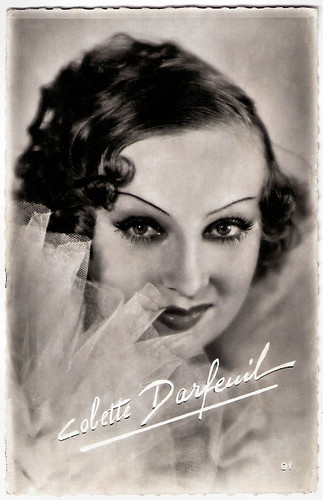
French postcard by Editions et Publications Cinematographiques (EPC), no. 91.
Source: Pascal Donald (CinéArtistes - French), Hal Erickson (AllMovie), AlloCiné (French), Les gens du Cinéma (French), Wikipedia (German and French) and IMDb.
This post was last updated on 28 November 2023.

French postcard by Europe, no. 588. Photo: G.L. Manuel Frères.

French postcard by Les productions J.N. Ermoliev / Tobis for the screening of the film at the Paris cinema Marivaux. Colette Darfeuil as the evil Sangarre, who plots together with Ivan Ogareff (Charles Vanel) in the French sound film Michel Strogoff (Jacques de Baroncelli, Richard Eichberg, 1936), based on the novel by Jules Verne.
Brown-haired ingénue
Colette Darfeuil was born Emma Henriette Augustine Floquet in Paris in 1906. As a girl, she was discovered by young director Pierre Colombier in the Gaumont studios when she accompanied a friend who would play a part as an extra.
She made her film debut in Les étrennes à travers les ages/New Year Gifts through the Ages (Pierre Colombier, 1920) with Dolly Davis. This was a short, silent comedy with animated sequences of women down the ages all wanting something different from what they got as New Year presents.
Three years later, her film career really took off with leading roles in Le retour à la vie/Back to Life (Jacques Dorval, 1923) and Château historique/Historic Castle (Henri Desfontaines, 1923) with Thomy Bourdelle.
In Germany, she appeared in Der Mann im Sattel/The Man in the Saddle (Manfred Noa, 1925) with Ernö Verebes and Angelo Ferrari. There she later also appeared in the comedy Was eine Frau im Frühling träumt/What a Woman Dreams About in Spring (Curt Blachnitzky, 1929).
But she mostly appeared in French films, such as the dramas La flamme/The Flame (René Hervil, 1926) with Charles Vanel, and Sables/Sand (Dimitri Kirsanoff, 1929) with Gina Manès. She had started her career as a brown-haired ingénue but in time turned into a blonde sophisticated lady.

French postcard by A.N. Paris, no. 272.
The end of the world
Colette Darfeuil made an easy transition from silent to sound with Abel Gance’s Science-Fiction film La fin du monde/The End of the World (1931). Hal Erickson at AllMovie: “As a comet speeds along on a collision course with Planet Earth, the world prays for a miracle. Scientist Victor Francen races against time to avoid the cataclysm, while Francen's religious-fanatic brother (played by director Gance) puts his fate in the hands of God.
Meanwhile, the governments of the world adopt near-fascistic methods to keep their panicking minions under control. Once all hope is abandoned, virtually all of civilisation degenerates into a drunken orgy, replete with rape and bestiality. The worst is reserved for last, as the ever-approaching comet causes a plethora of natural disasters before the final ‘Big Bang.’“
The 1930s were a busy decade for Darfeuil. It started with films like Cendrillon de Paris/Cinderella of Paris (Jean Hémard, 1930) and the comedy Voici dimanche/Here is Sunday (Pierre Weill, 1930) with Tony D’Algy. She played leads in Pour un soir..!/For one night...! (Jean Godard, 1931) opposite the young Jean Gabin, and the Guy de Maupassant adaptation Le rosier de Madame Husson/Mrs. Husson's Virginity Prize (Dominique Bernard-Deschamps, 1932) featuring Françoise Rosay.
Rex Ingram and his wife Alice Terry directed her in a supporting part in the Arab adventure Baroud (1932) with Pierre Batcheff. The British director shot his only sound film in Morocco, during the heyday of the French colonial empire, and retired shortly afterwards from the film industry. Russian director Fyodor Otsep directed her in the drama Mirages de Paris/Paris Illusions (1933) with Jacqueline Francell. This was an alternate language version of Großstadtnacht/Big City Night (Fyodor Otsep, 1932) with Dolly Haas and Trude Berliner in Darfeuil’s role.
Other films include Pour être aimé/To be Loved (Jacques Tourneur, 1933) with Pierre Richard-Willm, the Fernandel comedy Les bleus de la marine/The New Recruits of the Navy (Maurice Cammage, 1934), and Le roi des Champs-Élysées/The King of the Champs Elysees (Max Nosseck, 1934) with Buster Keaton.

French postcard by A.N. Paris, no. 272.
Seductive femme fatales
Colette Darfeuil had a successful career but never managed to become a real star. She often played seductive femme fatales, sometimes even vulgar characters. She was one of the pretty partners of the legendary silent star Ivan Mozzhukhin in the sound version of Casanova (René Barberis, 1933). She was directed by her husband Pierre Weill in Le train d'amour/Love Train (1935).
During the 1930s she mixed such starring parts with supporting roles in films like La chanson du souvenir (Serge de Poligny, Detlev Sierck a.k.a. Douglas Sirk, 1936), the French language version of the Ufa production Das Hofkonzert/The Court Concert (Douglas Sirk, 1936), both starring Márta Eggerth. A success was the adventure film Michel Strogoff/Michael Strogoff (Jacques de Baroncelli, Richard Eichberg, 1936) starring Adolf Wohlbrück a.k.a. Anton Walbrook. This was another alternate language version of a German production, Der Kurier des Zaren/The Czar’s Courier (Richard Eichberg, 1936) based on the novel by Jules Verne.
In Belgium, she played in several comedies by Gaston Schoukens, such as Bossemans et Coppenolle (1939) with Raymond Aimos, and in Italy, she made the romantic comedy L'amore si fa così/Love you so (Carlo Ludovico Bragaglia, 1939). She had a supporting part in the war drama Untel père et fils/Heart of a Nation (Julien Duvivier, 1945) with Raimu and Michèle Morgan. The film about how the people of Paris cope with the strains and struggles of war was shot in 1940 but not released in France until November 1945 because of WW II. It was released in the US in 1943.
After the war, she appeared in Jacqueline Audry’s Les malheurs de Sophie/The Misfortunes of Sophie (1946). That year, her mother died and from that point on she only accidentally worked for the cameras. In 1952, she played opposite Michel Simon in La fille au fouet/Girl with the Whip (Jean Dreville, 1952). She also played in the German version, Das Geheimnis vom Bergsee (Jean Dreville, 1952). It was her last film.
Aged 92, Colette Darfeuil died in 1998 in Montfort-l'Amaury, France. She was divorced from film director Pierre Weill and she was the widow of producer René Bianco.

French postcard by Editions et Publications Cinematographiques (EPC), no. 91.
Source: Pascal Donald (CinéArtistes - French), Hal Erickson (AllMovie), AlloCiné (French), Les gens du Cinéma (French), Wikipedia (German and French) and IMDb.
This post was last updated on 28 November 2023.
No comments:
Post a Comment